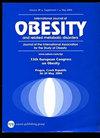青春期体重指数的遗传因素及其与成年体重增加的关系:对芬兰双胞胎长达 25 年的跟踪研究。
IF 4.2
2区 医学
Q1 ENDOCRINOLOGY & METABOLISM
引用次数: 0
摘要
简介青少年时期体重指数(BMI)高是成年肥胖症的一个重要预测因素。然而,这种关联的性质尚不清楚。我们利用从 11.5 岁到 37 岁的纵向数据,研究了青春期体重指数与成年体重变化之间的关系,并考察了这些关系背后的遗传因素:研究队列由1400对芬兰双胞胎组成(40%为男性),其中494对双胞胎报告了他们在5个年龄段的体重指数(BMI):他们分别在 11.5 岁、14 岁、17.5 岁、24 岁和 37 岁这五个年龄段报告了自己的体重指数(BMI)。使用线性混合效应模型计算了成年后(17.5 至 37 岁)的体重指数轨迹(定义为体重指数变化(即斜率)和基线年龄的体重指数(即截距))。利用 BMI 的多基因风险评分(PRSBMI)和遗传孪生子模型,分析了 BMI 轨迹中遗传因素的作用及其与 11.5 岁和 14 岁时 BMI 的关系:平均体重指数在成年后有所增加(男性为 4.06 kg/m2,女性为 3.39 kg/m2)。体重指数的变化与 17.5 岁基线年龄(即截距)的体重指数相关(男性为 0.24,女性为 0.35),也与青春期(11.5 岁和 14 岁)的体重指数相关。遗传因素对成年期体重指数的变化(与 PRSBMI 的相关性,男性为 0.25,女性为 0.27;遗传率估计值分别为 0.63 和 0.64)以及与基线年龄体重指数(男性为 0.5,女性为 0.54)和青春期(11.5 岁和 14 岁)体重指数(rA = 0.63-0.64)的相关性均有影响:我们发现,遗传因素在成年后的体重指数变化中起着一定作用,其中部分遗传因素与青春期体重指数的遗传因素重叠。青春期高体重指数的遗传易感性也与成年后体重增加有关。本文章由计算机程序翻译,如有差异,请以英文原文为准。
Genetic contributions to body mass index over adolescence and its associations with adult weight gain: a 25-year follow-up study of Finnish twins
High body mass index (BMI) in adolescence is a strong predictor of adult obesity. However, the nature of this association is unclear. We investigated how adolescent BMI is associated with adult weight change using longitudinal data from ages 11.5 to 37 years and examined the genetic factors behind these associations. The study cohort consisted of 1400 Finnish twin individuals (40% males) with 494 complete twin pairs who reported their body mass index (BMI) at five ages: 11.5, 14, 17.5, 24, and 37 years. BMI trajectories (defined as BMI changes (i.e., slope) and BMI at baseline age (i.e., intercept)) were calculated in adulthood (from 17.5 to 37 years of age) using linear mixed-effects models. Polygenic Risk Scores of BMI (PRSBMI) and genetic twin models were utilised to analyse the role of genetic factors underlying BMI trajectories and their associations with BMI at 11.5 and 14 years of age. Mean BMI increased in adulthood (4.06 kg/m2 in men and 3.39 kg/m2 in women). The BMI changes correlated with BMI at the baseline age of 17.5 years (i.e. intercept) (r = 0.24 in men and r = 0.35 in women) as well as with BMI in adolescence (11.5 and 14 years of age). Genetic factors contributed to the BMI changes during adulthood (correlation with PRSBMI r = 0.25 in men and r = 0.27 in women; heritability estimates 0.63 and 0.64 respectively) as well as to their correlations with BMI at the baseline age (rA = 0.5 in men and 0.54 in women) and BMI during adolescence (at 11.5 and 14 years of age) (rA = 0.63–0.64). We found that genetic factors play a role in BMI change in adulthood, and part of this genetic component overlaps with the genetics of BMI in adolescence. Genetic predisposition to high BMI in adolescence is also related to adult weight gain.
求助全文
通过发布文献求助,成功后即可免费获取论文全文。
去求助
来源期刊

International Journal of Obesity
医学-内分泌学与代谢
CiteScore
10.00
自引率
2.00%
发文量
221
审稿时长
3 months
期刊介绍:
The International Journal of Obesity is a multi-disciplinary forum for research describing basic, clinical and applied studies in biochemistry, physiology, genetics and nutrition, molecular, metabolic, psychological and epidemiological aspects of obesity and related disorders.
We publish a range of content types including original research articles, technical reports, reviews, correspondence and brief communications that elaborate on significant advances in the field and cover topical issues.
 求助内容:
求助内容: 应助结果提醒方式:
应助结果提醒方式:


